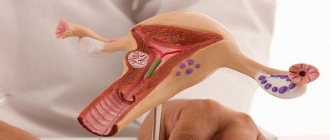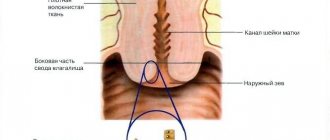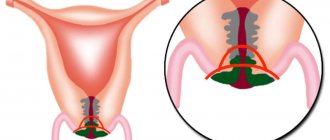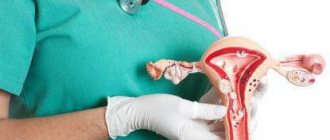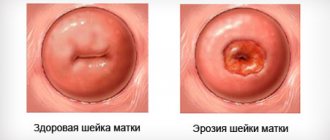What is cervical atresia
The term atresia or stenosis of the cervical canal refers to an anomaly in the structure of the cervix, consisting of narrowing or complete obstruction of the cervical canal. In the medical literature, the term means complete fusion of the walls of a hollow organ. Atresia can be partial or absolute. If the canal is not passable along its entire length, its complete fusion is diagnosed. If pathology is observed in the area of the external or internal pharynx, partial stenosis is diagnosed.
The main task of the gynecologist is to distinguish stenosis and atresia of the cervical canal from stricture. With stricture, cervical obstruction occurs due to scar deformities. The disease is detected based on the patient’s complaints and simple diagnostic procedures. The diagnosis of complete stenosis is determined when it is impossible to enter the uterine cavity with a probe with a diameter of 12 mm. The main danger of such a deformation is that it may have an oncological basis. To exclude the possibility of developing cancer, the patient undergoes an endometrial biopsy.
If the woman does not have atypical cells or negative symptoms, surgery is performed. It is worth noting that stenosis detected during menopause cannot be treated; patency of the cervical canal is restored only to women of childbearing age. In some cases, pelvic ultrasound and MRI are performed to diagnose the disease. It should be taken into account that atresia may be accompanied by structural disorders of the genitourinary system. To clarify the diagnosis, urethrocystoscopy is performed.
In medical practice, a distinction is made between acquired and congenital atresia. With congenital pathology, fusion of the cervical canal occurs at the stage of embryonic development. The reasons that provoke such deformation are as follows:
- infection of a pregnant woman with toxoplasmosis, chlamydia or syphilis;
- taking certain medications in the first trimester of pregnancy;
- exposure of a woman to ionizing radiation.
With congenital fusion, the symptoms do not bother the woman until puberty, or more precisely, until the first menstruation. Acquired atresia appears due to age-related changes or due to injuries to the cervical canal. Normally, the menopause period is accompanied by a significant decrease in the size of the uterus and cervix, a change in the structure of all tissues and organs that provide reproductive function. Such changes occur against the background of the cessation of estrogen secretion and cell insensitivity to follicle-stimulating hormone. Against the background of a decrease in the intensity of production, thinning of the epithelium occurs, resulting in a partial narrowing of the lumen of the canal. Over time, the stenosis progresses and complete fusion occurs.
The main causes of atresia that manifests itself during reproductive age may be the following:
- transferred electrocoagulation of the canal;
- chemical treatment of the cervix;
- violation of curettage technology during abortion;
- complicated course of endometritis or endocervicitis;
- cancer of the cervix or uterine body;
- consequences of past infections (tuberculosis, gonorrhea, chlamydia).
When atresia of the cervical canal appears in a woman, menstrual bleeding stops or its intensity significantly decreases. Such a symptom should be a cause for concern; the girl should urgently consult a doctor. The main danger is that menstrual blood accumulates in the uterine cavity and can cause infection.
The video and photos in this article will help the reader understand exactly how the operation occurs.
Treatment
Correction of the lumen of the cervical canal is indicated for infertility and impaired outflow of menstrual fluid. The asymptomatic course of atresia in the absence of atypical cells requires dynamic observation by a gynecologist once every six months with an ultrasound.
If necessary, restoration of the lumen is carried out surgically or through cervical bougienage. In the second case, a special rod is inserted into the canal - a bougie.
Initially, its diameter is slightly larger than the anatomical size of the structure. Bougienage is done over several weeks, each time using a larger bougie. For women in menopause, treatment is supplemented with the prescription of antispasmodics and hormone-containing drugs.
Surgical intervention is performed using several methods:
- Laser recanalization;
- Radio wave recanalization;
- Conization of the cervix;
- Tracheloplasty.
With frequent recurrence of narrowing of the canal, an alloplastic implant is installed in it. It prevents the walls from touching and prevents the lumen from becoming closed. After surgery, the patient is prescribed an antibacterial course.
What is dilation, or bougienage, of the cervical canal?
Expansion or bougienage of the cervical canal is a surgical operation performed to eliminate narrowing or fusion. The disease occurs in women of reproductive age due to various reasons, but often narrowing occurs due to curettage or age-related changes. The infection has a negative effect on the condition of the cervix. Patency is restored with the help of a simple manipulation, which is carried out using a special instrument called a bougie.
Bougienage is the only way to get rid of pathologies that limit a woman’s ability to conceive. This type of operation can be performed during menopause, but the procedure is done at the request of the woman. Reviews from patients who have undergone bougienage describe this procedure as painful, but this is not always the case. The main thing is to choose a good medical center. The manipulation is always carried out under anesthesia; doctors use equipment that significantly reduces the patient’s time in the hospital.
Attention! You cannot refuse the intervention. Against this background, the risk of developing inflammatory and cancer diseases increases. When the canal is completely closed, infertility is likely to develop.
Expansion of the cervical canal of the uterus can be done by acute or blunt means. The most common way is to use special dilators. The essence of the method is that devices with different diameters are inserted into the channel one by one. The size is gradually increased by 0.5 - 1 mm.
The procedure is carried out as follows:
- The cervix is processed and exposed using speculum.
- Using bullet forceps, grab the front lip and move it towards the entrance to the vagina.
- The cervical canal is wiped with an alcohol solution.
- After fixing the vaginal part, a uterine probe is carefully inserted into its cavity, the position and size of the uterus is determined.
- The surgeon holds the bullet forceps with his left hand and begins to expand the canal.
- Hegar dilators are alternately inserted into the canal towards the uterine cavity, taking into account its location. Dilators should be inserted slowly; with physiological anteflexion of the uterus, the handle should be lowered down.
- The end of the dilator should go beyond the internal os, but you need to control the process so that the device does not reach the bottom of the uterus.
The first numbers of dilators with partial fusion are found quite freely. As the diameter increases, resistance is felt in the internal throat. At this moment, the gynecologist should work carefully, without making sudden movements. You need to remove the dilator slowly and immediately insert the next one, not allowing the internal pharynx to contract. If one of the next expansion tubes cannot be passed through the internal throat, insert the previous one and leave it in the canal for several minutes. The procedure is carried out very carefully without sudden, violent movements.
Indications for intervention
The list of main indications for intervention and expansion of the cervical canal includes the reasons that provoke pathological narrowing or overgrowth. This list includes the following conditions and diseases:
- infectious pathologies;
- taking certain medications for a long time;
- contact with ionizing radiation;
- poor quality of the procedure for curettage of the uterine cavity;
- cauterization of polyps or cervical erosion;
- consequences of obliteration;
- cervical cancer;
- late term abortion;
- endocervicitis;
- hypertrophic scarring.
Diagnostic measures
If you suspect cervical canal atresia, you should definitely consult a gynecologist. The primary examination consists of establishing the clinical picture, assessing the patient’s sexual and physical development, and visual examination of the genital organs. The gynecologist is able to identify smoothing of the cervix, flattening of the vaginal vaults, or the absence of these signs if the patient is healthy. With atresia, pressure on the uterus causes pain, and the organ has the shape of a ball.
The final diagnosis can be made after the probing procedure. Ultrasound and ultrasonic hysterosalpingoscopy document the results obtained during the examination. Complex and atypical cases of atresia are diagnosed using MRI in different projections.
How does the intervention work?
The bougienage procedure is carried out in a hospital setting under general anesthesia. Local anesthesia is used less frequently because it is considered ineffective. The type of anesthesia is determined by the doctor after a complete examination of the woman. The surgical technology involves the introduction of special instruments into the cervical canal.
Attention! Without anesthesia, the patient will feel pain, and the risk of injury to the mucous membranes due to sudden movements will increase.
The diameter of the bougie increases gradually; if the technology is not followed, cervical rupture is likely. In case of accidental injury, the risk of re-occlusion of the cervical canal increases. Correctly performed dilation guarantees the absence of complications. Bougienage is prohibited if the fusion occurs against the background of a malignant process. In this case, radical operations are used. Bougienage is not performed if a woman has had false amenorrhea for 6 months. Hormonal testing can help detect this condition. In this case, plastic canalization of the cervix is performed.
After the operation, the woman can go home, but sometimes the doctor recommends staying in the hospital. This condition reduces the likelihood of bleeding. Outpatient treatment is acceptable in the absence of pathologies of the heart and blood vessels. Local anesthesia is used if general anesthesia cannot be administered.
Preparation for the operation
To reduce the risk of complications, a woman needs to undergo a series of preparatory examinations. They are needed not only to confirm the diagnosis, but also to establish the general state of health. The set of diagnostic measures includes:
- general blood analysis;
- blood chemistry;
- test to detect sexually transmitted infections;
- test for HIV, syphilis, hepatitis B and C;
- blood clotting test;
- colposcopy;
- microscopy of vaginal and cervical smears;
- electrocardiogram;
- fluorogram;
- probing;
- bacterial culture from the vagina;
- Ultrasound examination of the pelvic organs.
The woman should visit an anesthesiologist. On the day of the operation, drinking water and food is prohibited. The prohibition is due to the fact that nausea and vomiting may occur during intravenous anesthesia. The cost of the procedure differs in many clinics. When choosing a medical center, you need to take into account its reputation and the qualifications of its doctors.
Symptomatic manifestation
Congenital atresia has one important symptom - the absence of critical days in a girl whose body has all the signs of cyclical changes. This condition is called false amenorrhea. Menstrual fluid accumulating inside the uterus stretches the organ and causes pain.
The condition may also be characterized by the presence of:
- Nausea;
- Vomiting;
- Spasms;
- Elevated temperature;
- Problems with the functioning of the bladder and gastrointestinal tract.
In rare cases, a girl may even lose consciousness. During a gynecological examination, the cervix is smoothed, the organ takes on a spherical shape and is very painful on palpation. In postmenopause, atresia is asymptomatic, and the woman may not be aware of its presence at all. It can only be identified through diagnostic measures.
Period after surgery
After the operation, the woman can return to normal life within 2 weeks. During this period, all pain completely disappears. If the pain intensifies within 14 days, you should consult a doctor immediately. There is a risk of infection. During postoperative treatment, a woman is advised to take anti-inflammatory drugs and use suppositories that have wound-healing properties.
Attention! Such drugs are prescribed by a gynecologist, taking into account the general state of health and tolerability of individual medications.
You should consult a doctor in the following cases:
- bleeding from the vagina and excessive secretion of mucus from the genitals;
- pain in the abdomen and lower back does not go away within several days;
- body temperature rises.
To prevent the development of negative consequences after probing the canal, the patient is advised to take antibiotics.
Symptoms of obstruction of the fallopian tubes and vagina
Quite often, this unpleasant symptom occurs: blood refluxes through the uterine tubes into the abdominal cavity. It all ends with unbearable spastic pain in the lower abdomen and severe irritation of the abdominal area.
The fistulous form of vaginal atresia often appears in adolescents and is characterized by the addition of an infection. As a result, purulent discharge constantly bothers me. It is dangerous when pus ends up in the abdominal area. It all ends with a sharp stomach. The patient's condition deteriorates sharply. If measures are not taken promptly, the infection will lead to peritonitis and death.
How to prevent overgrowth
Compliance with the following rules helps prevent the development of the problem:
- timely treatment of various inflammatory processes affecting the central canal and cervix;
- regular visits to the gynecologist to identify inflammatory processes and malignant neoplasms;
- prevention of unwanted pregnancy, reducing the frequency of abortions;
- refusal of self-medication;
- compliance with the rules of a healthy lifestyle;
- the use of barrier methods of contraception to prevent bacterial infection.


